Podcast: Play in new window | Download (Duration: 33:40 — 41.8MB)
Subscribe: Apple Podcasts | Spotify | Amazon Music | Android | Pandora | iHeartRadio | JioSaavn | Podcast Index | Email | TuneIn | RSS | More
By Davy Crockett
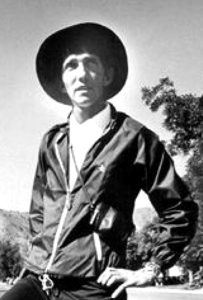 This is the second part of the Dave Kunst story. Read/Listen/Watch to Part 1 here.
This is the second part of the Dave Kunst story. Read/Listen/Watch to Part 1 here.
Dave Kunst, originally from Minnesota, now from California, claims that he was “the first person verified to have completed circling the entire land mass of the earth on foot.” Kunst’s 1970-74 walk has historic importance for the modern-era of ultra-distance walking. I believe that Konstantin Rengarten was actually the first in 1894-1898 (See Part 3). I will show that Kunts’ “verified” claim is dubious, but his amazing walk did happen, and the story is fascinating and exciting. But at what cost to those who believed in him? With the end just days away, everything seemly fell apart.
In 1970, Dave Kunst of Waseca, Minnesota, started a walk around the world with his brother John. Part 1 of this story covered their travels east to New York, by plane to Portugal, and then on foot with a mule to Afghanistan where John was shot and killed by bandits. Dave was wounded and returned to Minnesota to recover in November 1972.
Dave felt strongly that the walk should be continued, and he deeply wanted to get back on the road to experience an exciting and free life, without family, job, or financial obligations. He said, “The walk will definitely go on. I want to keep the ball rolling. I will be back to finish what my brother and I started so he will not have died for nothing.”
Plans to resume the walk
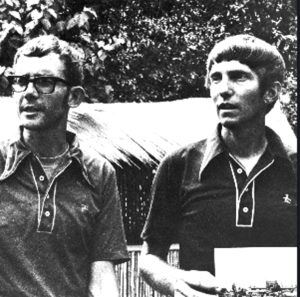

In January 1973, only three months since he had been shot in the chest, Dave Kunst announced that he would resume his walk in March 1973 with his brother Pete. They would travel back to Afghanistan and resume the walk from the mountain pass where their brother John was killed. Dave said, “Pete’s wife was reluctant before, but now she is in favor of it.” Pete said, “It’s too important to all of us to abandon this idea now. My wife understands this, especially since John gave his life for it. We have to finish the job.”
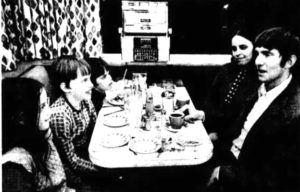



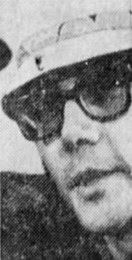

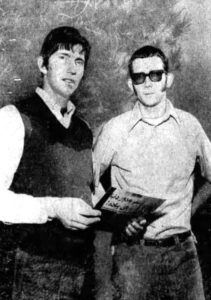

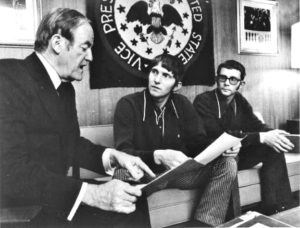

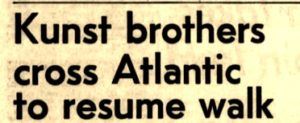

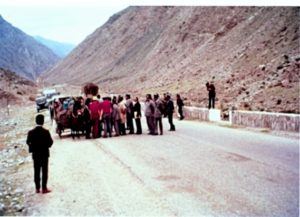

The two restarted the walk on March 26, 1973 from the exact location where John had lost his life. The American Embassy provided transportation to the restart point for Dave, Pete, the mule and the cart. Eight Afghan policemen with two motor cycles and two jeeps provided protection for the Kunst brothers until they reached the Pakistan border. The event was covered by media across the world.
Pakistan
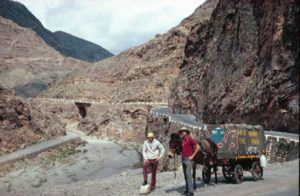

In Pakistan, they were accompanied by armed tribal guards called the Khyber Khasadar, who guided them over Khyber Pass. It was said in a Pakistani paper that the Kunst brothers were the first non-Asians to walk “to and through” the pass. The Pakistani Tribal Prince walking with up toe the top of of the pass.
They were guided to the border town of Peshawar, Pakistan. There, they were special guests of the town’s commissioner. At Islamabad, Pakistan, the two rested for more than a week. Dave wrote, “I gave a talk to a group of young Pakistani men. They all seemed to want to know what Americans felt about the Pakistani prisoners of war in India and why the U.S. didn’t help Pakistan in the war.” He found the young people there to be very politically minded
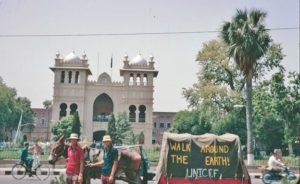

At Lahore, Pakistan, it was very hot when they arrived. The tourist bureau kindly greeted the brothers when they entered the city with about a dozen cokes in a bucket of ice and water for their mule.
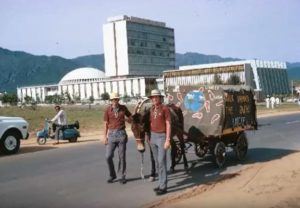

They stayed with American Embassy in Islamabad, Pakistan for about a month trying to get permission to walk across China. They wished that the U.S. government would help. But Presidential foreign affairs adviser, Henry Kissinger felt the U.S. government should stay of it. “It might raise questions in Chinese minds about the independent efforts of these American boys.”


India
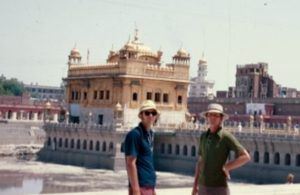

They crossed the border into India and visited the Golden Temple in Amritsar. There, they had to walk barefoot through a small ditch of water to cleanse their feet before entering the compound. Willie Make-It II had to stay outside the walls that encircled the sacred place.
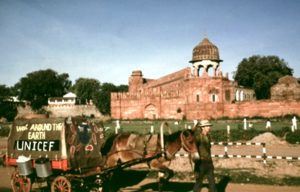

In June, 1973, after another 300 miles, they reached New Delhi. They had covered about 800 miles since they had resumed their trip three months earlier for an average of about nine miles per day. They had taken many days off and stopped in New Delhi for a couple weeks.
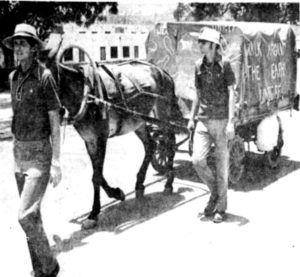

Dave and Pete knew that the next 900 miles to Calcutta would be dangerous through the very populated country with many gangs and bandits. They were concerned about the seasonal monsoons that would soon arrive with heavy rains causing roads to be closed. The truck traffic was massive so they had to walk in the mud alongside the main pavement.


About India, Dave said, “It is the most unpleasant country we’ve seen. People drove us crazy, the monsoons soaked us and India’s governmental bureaucracy burdened us. Pete got sick from the food and our mule developed sores from poor diet and the hot, damp climate.” Because of Pete’s sickness, he did not walk much of the way to Calcutta. He hitched rides to leapfrog ahead of Dave. It makes you wonder if Dave also used this approach during times when he was ill. It is a distinct possibility and a good reason to be skeptical if the entire walk was legitimate. Since there was no true verification taking place by witnesses, we will never know.
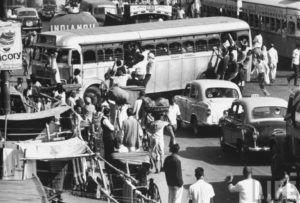

Dave and Pete arrived at Calcutta on the east coast of India in late August, 1973. They knew China and Berma wouldn’t let them cross their counties and southeast Asia was war-torn. Dave’s plan to walk as straight as possible across the world came to an end. But using Australia as an alternative seemed to make sense and is allowed in modern-day recognized walks around the world. So, they made plans to head to Australia, but still had hopes to do some walking later in Hong Kong.
After more than a month’s delay because of custom problems and a dock strike, they bid goodbye to their faithful mule Willie Make-It II, who could not make the trip to Australia. Dave and Pete continued, bound for Perth, Australia to continue their walk on that continent. Since resuming the walk, they had covered about 1,800 miles in about five months.
Australia
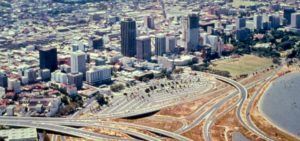

On September 26, 1973, they flew into Bangkok, Thailand, and the next day flew to Singapore. There, they were further delayed because the Russian ship carrying their wagon was delayed. They finally arrived to Perth in mid-November. Dave said, “We first have to find a replacement for Willie Make-It. We’ve been offered a mule from a station 620 miles north of Perth, but we’ve got a problem getting it to Perth.” They received wonderful hospitality in Perth. The mule arrived from Northern Australia and was presented to the Kunst brothers by the Australian Tourist Commission.
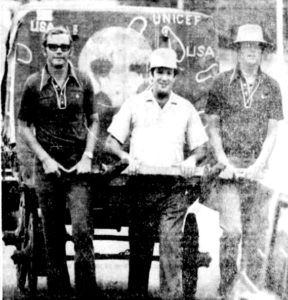

The cart finally arrived. In December 1973, they were still in Perth, making preparations, Dave wrote, “We are looking forward to nature at its rugged best, with temperatures of 120 during the day and 40 at night. The main thing we are worried about are the flies. They are thick, always getting in your eyes, ears, mouth and nose.”
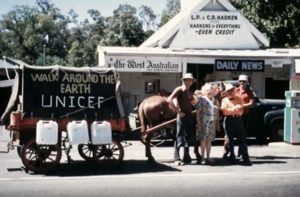

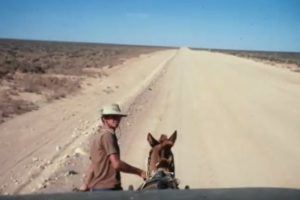

By late February 1974, they had covered about 900 miles in Australia. The mule was doing better. They said the people in Australia had been very kind to them, supplying them with food and shelter and even clothing when they needed it along the way. A curious picture was taken in Australia showing one of the brothers walking and the other on the cart, taking the picture. Did they take turns riding on the cart? Again, despite Dave’s later claim, no validation was taking place to make sure this was not happening.
On March 7, 1974, they entered Ceduna, Australia after walking 252 miles of dirt road across the Nullabor Plain. Pete was suffering from leg and foot problems and decided to give up the walk at Ceduna and return home to California. Dave said, “He has done all and more than I asked of him and this will always be a Kunst brothers’ world walk.” Dave believed he could pick up the pace to 35 miles per day if the mule could keep up.
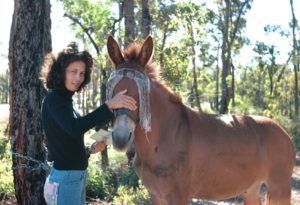

Dave would not be alone. A few months later, he very publicly told details how he had not been a faithful husband on his trek during those walking years. He had the company of many women, especially when they would stop for a few weeks. While waiting in Perth, Australia, he met a young school teacher, Jenni Samuel, ten years his junior, originally from Berma. They fell in love and lived together. Jenni did not know he was married. Dave wasn’t writing personal letters to his wife back in Minnesota. He only sent her the notes from his journal which she faithfully typed up for him.
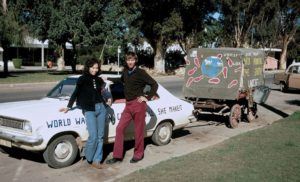

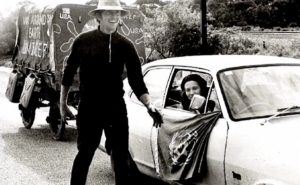

Driving the car at a speed that Dave could walk, burned out two clutches. It frustrated Jenni, because driving so slow was boring. She wanted to drive ahead and wait, leapfrogging. But Dave insisted the car with the cart had to be alongside him, or he would be just another guy walking.
There was more criticism expressed in editorials about his walk. One animal lover wrote, “I was upset to read that his third mule had died. I don’t know how beneficial his walk will be for UNICEF, but I am terrible opposed to his doing this at the expense of any animals.” Dave’s mother replied in the newspaper, “Our boys appreciated all three mules and took very good car of them. The mules were regularly checked by veterinarians, had their daily ration of oats, hay and water and were rested during the day, especially during the very warm weather.”


California
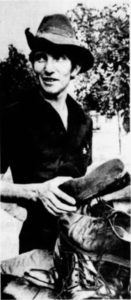

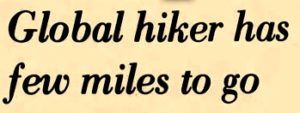

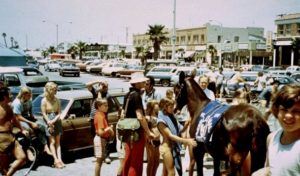

Dave didn’t want to take a mule with him the rest of the way back to Minnesota, but his brother Pete talked him into it, saying that it “would be good for your image.” Pete was wise about public relations. The Santa Ana Chamber of Commerce provided him a mule that had retired from Knotts Berry Farm. On July 28, 1974, he started walking east again from Newport Beach, California. The mule only lasted two days and refused to cross an intersection. Many people tried to help including a policeman who inched his car forward behind the mule. It kicked out a headlight. Dave continued without the mule, and only carried a small backpack, initially with just one canteen.
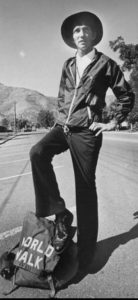

Utah
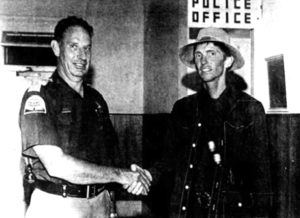

Dave was seen walking up the narrow Virgin River Gorge to St. George, Utah. He chatted with police and other visitors. “He has suggested a friendly wave would be much more safe than stopping to visit along the highways.”
He kept in close touch with Jenni, calling her collect often, running up a $500 phone bill. Jenni wrote letters to him every day delivered to post offices.


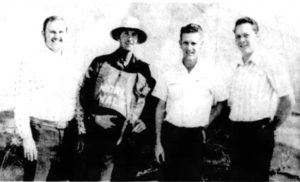



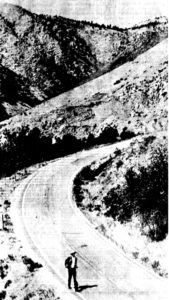

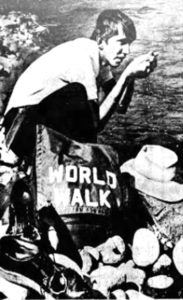

One night he was walking along the interstate and it was very cold. “I stopped at a rest stop for a few hours sleep but it was too cold. I went into the men’s bathroom and kept punching that button on the electric hand dryer until the place warmed up. Now who else would think of that?”
As he walked through Colorado, on network TV, they played his recorded interview on the Tomorrow Show, a late-night program. Near Denver, walking in 90 degree heat he said, “I’m anxious, really anxious now. I see the end in sight. I have about 1,000 miles left to go. I don’t think I’d ever do it again, although it has been a wonderful experience. It has been pretty tough. It really was enjoyable walking through the clean, crisp mountain country in Colorado. Everything was so green. The trip would have been a cinch if it had all been like that.”
Nebraska
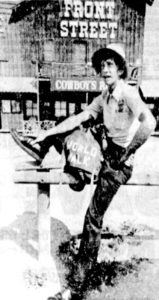



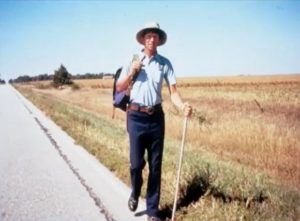

Family at home
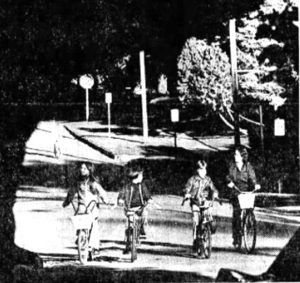

But there were clues in here interview that it had been hard on her. “It’s not something I’d do, but I’m not him. We’re different people and we think differently. He needed to do it, so it was good for him to go ahead with it.” It was clear that Dave had not shared much personally with her about the walk, or even about the shooting.
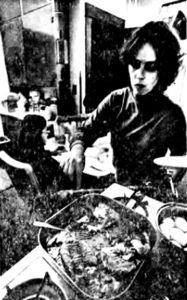

She said, “Sometimes people ask me, ‘What do you think about him being away from you so long, you know, what with all those women all over the world? And I really can’t answer. It’s something you try not to think about, I mean you can’t help thinking about it sometimes, but you try not to. Dave, says you just can’t worry about every little thing, and I think that’s right. Still, sometimes . . . .”
She pretended that she expected him to return to the family. “It won’t be easy for any of us. We’ll all have to readjust. We’ve all changed some and we’ll have to find out how much, and what to do about it. Things will be a little mixed up for a while I think.”
Dave’s huge public relations blunder
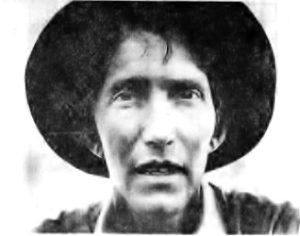



Dave revealed his true colors just days before thousands of people planned to celebrate his finish. Clearly, he was tired of hiding behind the false, clean persona he had been putting forth for four years.
He said, “I’m a social deviate, a radical, an oddball, even a little crazy. I don’t fit into anybody’s pattern and never will. I feel a little uneasy about ending the trip. My home has been where I hang my hat, and I like that feeling. I’m not ending the trip to become domesticated. I’ve learned a lot about myself. I know that I’m not going to waste time doing things I don’t like anymore, like trying to make a marriage work when there’s nothing to work with.”
Wolfe wrote, “He can talk for hours about himself and freely admits that.” Dave said, “I’ve got an ego as big as they come. I love the attention I get from the press and television and from people who’ve heard about me and stopped to talk.” He added, “And, let’s face it. I’m not a priest. I’ve known a lot of women all over the world, and it didn’t always end with a handshake. I’m not bragging. Sex is a natural part of life. Going without for 4 ½ years would be unnatural.”
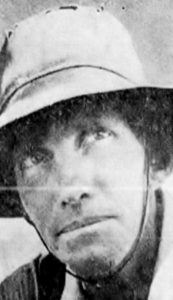

![]()
![]()
![]()
![]()
His greed showed as he stated that he was in the market to write a book and wanted a $10,000 advance plus royalties. “It’s not going to be a travelogue. It’ll be more about what I learned and thought as I traveled. I want to tell what I think about people, people I like and some I don’t. I want to write about my attitudes, my parents, my family, people I know, all the things that have gone together to make me what I am now.” He reflected on why he really did the walk. The true reason was to be feed his ego, to be the first one to walk around the world. “To take something the seems impossible and to go ahead and do it, not matter what. If you can walk around the world, then you can do anything.”
Initial Reaction
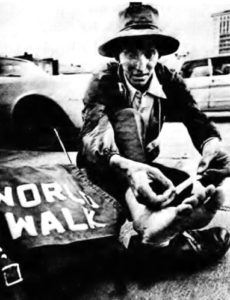

When the article came out, Dave read it in Omaha, Nebraska and was very pleased with it. He loved it and wrote, “Finally someone has written down what I think about things.” He knew it made him sound like a terrible person, but he liked that. He liked to shake people up. “I stood there in the drug store in the middle of Omaha, grinning like crazy, reading sections of the article over and over again to myself. There I was on page one as big as life. It sure made me feel good.”


Some people just could not believe that Dave said such things and he was tracked down in Iowa. He doubled down on his words and was angry over the phone. After all his hometown had done for him, he foolishly trash-talked the town further. “There have been towns I’ve walked through that have been better to me than Waseca. It is using the celebration for personal gain and not for my benefit.”


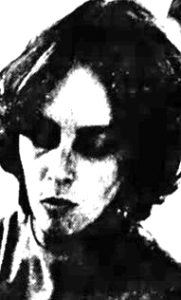

But Jan’s life was now in turmoil because of Dave’s selfish public rebuke. She said, “I never thought he would make a public issue out of our marriage. Everybody is up in arms in Waseca now. They’ve canceled a car he was going to have. Even if they go ahead with the homecoming, I doubt that many people would be there. I’m not sure I would. It hurts, what he said about other women, but I still love him. If he wants to try again, I’m willing. I just can’t understand why he ruined everything so close to the end of it.” His mother living nearby in Iowa was also deeply hurt by his words.
Impact at Waseca
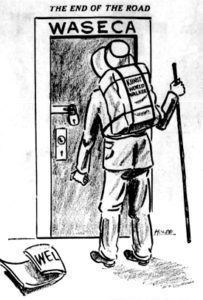

Hal Greenwood, president of Midwest Federal Saving and Loan Association, and president of UNICEF in Minneapolis, who had significantly helped finance Dave’s trip, said, “Dave is not not the vision of he guy I first saw about five years ago. I was sincerely dedicated to him. Now I’m disturbed and disillusioned. I’m withdrawing my identification with him.” That shocked Dave, because Greenwood had been his biggest backer. “To have him think that a few remarks of mine made the whole walk meaningless makes me feel terrible.”
One resident said what many felt. “I had misgivings about him leaving his wife and kids and going around the world in the first place. All this reconfirms my original thoughts.” The owner of the original Willie Make-It had been planning to give the mule to Dave as a homecoming present. He withdrew that offer.
It was said, “To his angered home-towners, he started out with flag waving four years ago and is coming back thumbing his nose.”
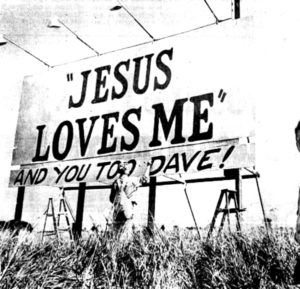

The mayor announced that he would refuse to participate in the homecoming celebration.
Another town in Minnesota editorialized, “You wouldn’t imagine that anyone with much common sense and decency would jeopardize the benefits of the UNICEF organization by some deliberately provocative and unnecessary remarks. Except possibly for some vicarious satisfaction for himself, he had nothing to gain from his rude remarks. He’s handled his homecoming like a clod.”
Others still supported him. “I admire Kunst for both his walk and his candor. It is a man of rare quality to make the statements he did. He chose to be frank and honest.” Another wrote, “How many of us would even consider a walk around the world, much less do it? David might not go to church, but as far as I’m concerned, he’s quite a man.” And, “Harrah for Dave Kunst. He has the guts to speak his mind and tell it the way he sees it.” Finally, “David Kunst should be respected, admired and accepted by all, if only for his achievement.”
Dave felt no remorse, and from the road in Iowa, said the flap was unimportant and that he would like to finish in Waseca at 3 a.m. when nobody would be around. Various reporters came out to walk with him and tried to clarify his story.
Approaching Waseca
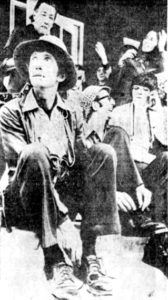

Dave entered Minnesota and was due to arrive in Waseca at 1:30 p.m. on October 6, 1974. His brother Pete came out to walk the stretch along with the original mule, Willie Make-it. Dave said, “Two Kunst brothers started this trip and we said two Kunst brothers would finish it.” Pete was seen weeping for at the mention of his slain brother.
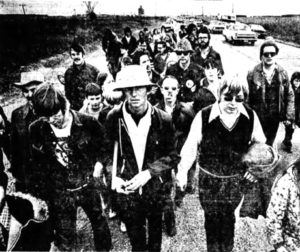

Those out to watch him walk in were asked what they thought. “I think a great many were upset about his comments.” Were people still angry? “I don’t think they are angry anymore. It was just the shock of what he said. A lot of people have forgiven him.”
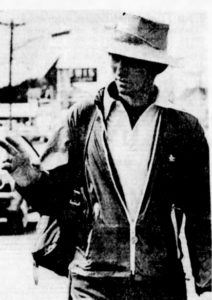

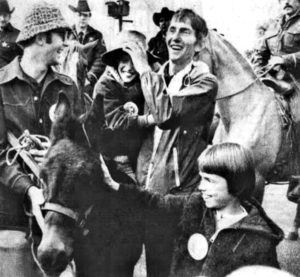

Church bells clanged as he entered the town. People were standing in doorways, curious and watching. Some were smiling and waving. The crowd grew. Flags waved and the high school band played the national anthem. Dave’s children joined him, but Jan did not. It was rumored that she was somewhere back in the crowd.
The finish
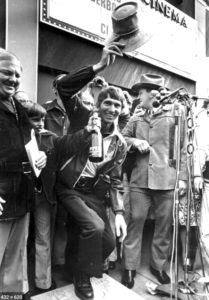

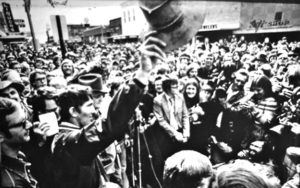

It was later reported, “Dave Kunst strode into his hometown Saturday afternoon to a tumultuous welcome from an estimated 5,000 people who swarmed around him seeking autographs, or just a touch from the only man who has walked around the world. The crowd lining the streets left little doubt. Whatever Dave Kunst’s personal views, he was Waseca’s hero.”
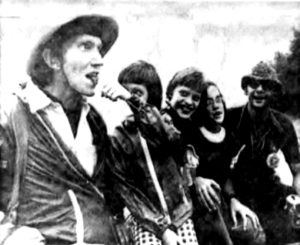

At a press conference, Dave said, “There are good and little people in Waseca, just like in every other town. But right now it looks to me like there’s a lot of big people in Waseca.” He talked for about 45 minutes and received applause and laughter. He did say some kind things about his wife, Jan. “She’s done a hell of a job. I don’t think I understand her. I’m sure she doesn’t understand me.” He said her domestication and his liberal ways caused mutual resentment.
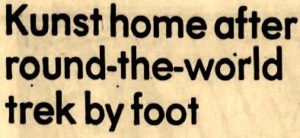

Aftermath


![]()
![]()
In mid-October, 1974, Dave appeared on a television show in New York City but then didn’t appear publicly for awhile. He went to Pete’s home in California. A month later, his children received letters from him telling them to “help their mother, keep up with their school studies and to be good.” He said he was concentrating on writing his book. He reminded them that “we’re free to go where we wish and to be what we are.” He said that people who make their own rules get special pleasure out doing something well, even if only for themselves.”
![]()
![]()
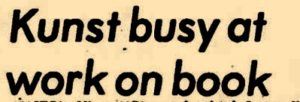

The years following the walk
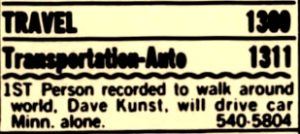

In January 1976, apparently still without a job, Dave was looking for a cheap way to take a trip back to Minnesota using someone else’s car, still trying to use his celebrity status for favors. He also announced that he wanted to do a drive around the world for the 1976 bicentennial but could not find a sponsor.
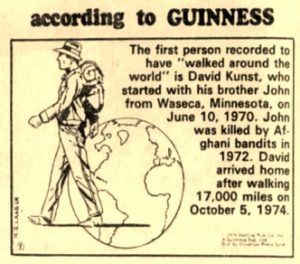

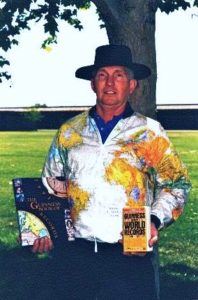

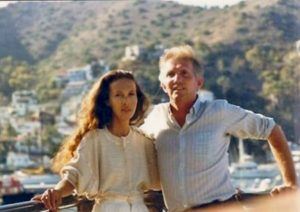

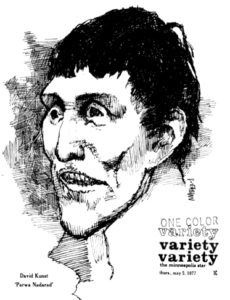

Without the millions he hoped for, he was working his paper route and as a caretaker for an apartment building. He was frustrated with his inability to cash in on his adventure and still couldn’t understand that he had killed those opportunities himself.
He hoped for a TV movie with Clint Eastwood playing his role. That didn’t get any traction. He finally was trying to find a better way to support himself and was taking real estate and business courses at a junior college. At age, 38, he said, “I haven’t grown up yet, and I like that. My personal opinion is that most people in this world are gutless.” He again railed against organized life, religion, and marriage. He didn’t mention that he had remarried. He still was very down on Waseca, Minnesota and the criticism that he received for leaving his family to go on the walk. He criticized their way of life and he still hoped to publish a book. “Those people are living their lives and I’m living my life, and it really doesn’t matter.”
The Man who Walked Around the World Book
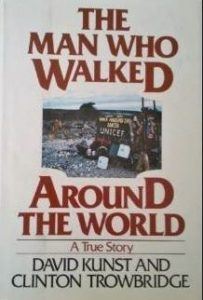

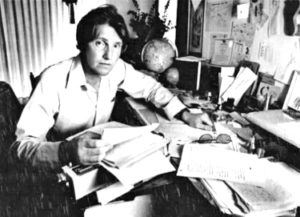

The book told a tale of a man with a big ego enjoying himself greatly on his trip. He boasted and told of his exploits with many women and with not remorse, wrote about his lack of kindness toward his wife who had taken care of his children back home. He told many stories that never were covered in the newspaper stories, some very interesting. I chose not to include those stories in this history and refer the reader to his book. Toward the end, he reprinted the entire controversial article published near the end of his walk. He was still very proud of every word and had no regrets. While out of print, used versions of his book can still be obtained.
A reviewer in Minnesota wrote, “After just enduring 33 pages, I have given up. Life is simply too short to waste any more time on such nonsense. He went on to point out many strange statements in the book. No, Dave did not make his million dollars on the book but he was able to go on a book tour and get on radio shows.
Lectures
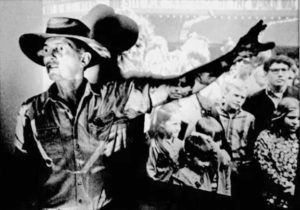

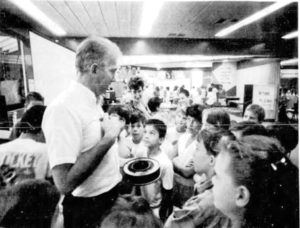

In 1994, Dave returned to Waseca to celebrate the 20th anniversary of his walk, but said, “not too many townspeople showed up.” In 1996 he was honored to be able to carry the Olympic torch for a segment in California of its journey to the Atlanta Games.
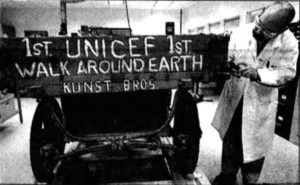

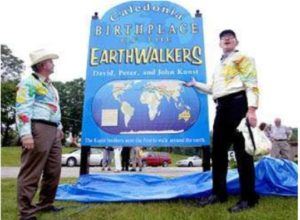

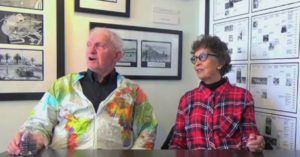

Dave Kunst followed a dream. After closely examining his walk, I feel confident that he really did it. He achieved an enormous goal and endurance accomplishment. He demonstrated in the modern era that walking around the world was possible.
Read all parts:
- Part 1 – Around the World on Foot (1875-1895)
- Part 2 – Around the World on Foot Craze (1894-96)
- Part 3 – Around the World on Foot (1894-1899)
- Part 4 – Around the World on Foot – The Bizarre
- Part 5 – Races Around the World on Foot – Dumitru Dan
- Part 6 – Walking Backwards Around the World
- Part 7 – Dave Kunst – Walk Around the World – 1
- Part 8 – Dave Kunst – Walk Around the World – 2
Sources:
- The La Crosse Tribune (Wisconsin), Jun 28, 1970, Oct 23, 30-31, Nov 12, 1972, Jan 4, Feb 5, 1973, Jul 24, 1974, Aug 15,16, 1974
- Traverse City Record-Eagle (Michigan), Jun 1, 1970
- Star Tribune (Minneapolis, Minnesota), May 24, Jun 26, Oct 14, 1970, Jan 29, Feb 12, Apr 2, Jun 20, Oct 27, 1971, October 23, 1972, Feb 22, Mar 1, Apr 2, 1973,Jun 3, 1973, Jan 2, Jun 7, Sep 15, 22,24,26 Oct 5,6 1974, Oct 28, 1979
- The Winona Daily News (Minnesota), Jun 24, 28, Nov 8, Dec 22, 1970, Apr 5, 1971, Aug 24, 1972, Mar 5, Sep 13, 1973, May 2, 1974, Jun 19, Aug 28, 1974, Jun 14, 2004
- Leader-Telegram (Eau Claire, Wisconsin), Jul 4, 1970, Feb 29, 1972
- The Capital Times (Madison, Wisconsin), Jul 9, 1970
- The Daily Chronicle (De Kalb, Illinois), Jul 16, 1970
- The Courier-News (Bridgewater, New Jersey), Jul 22, 1970
- The Times (Munster, Indiana), Jul 24, 1970
- The Evening Review (East Liverpool, Ohio), Aug 17, 1970, Jun 3, 1971, Feb 10, 1972
- Pittsburgh Press (Pennsylvania), Aug 18, 1970
- Pittsburgh Post-Gazette (Pittsburgh, Pennsylvania), Aug 19, 1970
- The Ligonier Echo (Pennsylvania), Aug 26, 1970
- Public Opinion (Chambersburg, Pennsylvania), Sep 1, 1970
- The Morning Herald (Haberstown, Maryland), Sep 2, 1970
- Intelligencer Journal (Lancaster, Pennsylvania), Sep 5, 1970
- The Central New Jersey Home News (New Brunswick, New Jersey), Oct 1, 1970
- The Bismarck Tribune (North Dakota), Oct 14, 1970
- Daily News (New York City), Oct 8, 1970
- The La Crosse Tribune (Wisconsin), Nov 7, 1970
- The Daily Tribune (Wisconsin Rapids), Dec 4, 1970
- The Baltimore Sun (Maryland), Dec 9, 1970
- Orlando Evening Star (Florida), Dec 10, 1970
- The Corpus Christi Caller-Times (Texas), Feb 1, 1971
- The Minneapolis Star (Minnesota), Apr 22, 1971, Dec 4, 1972, Jul 12, 1973, Sep 24,28, Oct 5, 1974, May 5, 1977
- Vidette-Messenger of Porter County (Valparaiso, Indiana), Jun 3, 1971
- Kingsport Times (Tennessee), Jun 9, 1971
- The Star Press (Muncie, Indiana), Jul 25, 1971
- Des Moines Tribune (Iowa), Aug 3, 1971
- Argus-Leader (Sioux Falls, South Dakota), Oct 28, 1971, Jul 13, 1973
- Fond Du Lac Commonwealth Reporter (Wisconsin), Nov 18, 1971
- Wilmington News-Journal (Ohio), Feb 10, 1972
- The Cloud Times (Saint Cloud, Minnesota), Mar 14, 1972, Apr 30, Jul 3, 1973, Feb 25, 1974, Sep 4, Oct 7, 1974, Ot 2, 1975
- Waukesha Daily Freeman (Wisconsin), Oct 24, 1972
- The Journal Times (Racine, Wisconsin), Oct 25, 1972
- Quad-City Times (Davenport, Iowa), Nov 7, 1972
- The Honolulu Advertiser (Hawaii), Feb 12, 1973
- The Daily Journal (Fergus Falls, Minnesota), Apr 28, 1973
- Ames Daily Tribune (Iowa), May 14, 1973
- Wausau Daily Herald (Wisconsin), Sep 13, 1973
- The Tampa Times (Florida), Sep 27, 1973
- The Sydney Morning Herald (Australia), Nov 18, 1973
- The Des Moines Register (Iowa), Dec 14, 1973, Jul 20, 1974
- Globe-Gazette (Mason City, Iowa), Jan 17, 1974
- The PIoneeer (Bemidji, Minnesota), Mar 15, 1974
- Independent (Long Beach, California), Apr 16, 1974
- Times-Advocate (Escondido, California), Jul 23, 1974
- The Daily Journal (Fergus Falls, Minnesota), Jul 29, 1974
- The Gunnison Valley News (Utah), Aug 22, 1974
- The Salina Sun (Utah), Aug 22, 1974
- The Daily Spectrum (Utah), Aug 22, 1974
- Greeley Daily Tribune (Colorado), Aug 31, 1974
- Akron Beacon Journal (Ohio), Aug 31, 1974
- The Lincoln Star (Nebraska), Sep 20, 1974
- The Daily Journal (Fergus Falls, Minnesota), Sep 26, Nov 29, 1974
- The Town Talk (Alexandria, Louisiana), Dec 3, 1794
- Waukesha Daily Freeman (Wisconsin), Oct 8, 1974
- The Los Angeles Times (California), Jan 11, 1976, Jun 25, 1978, Aug 1, 1984
- Tallahassee Democrat, (Florida), August 19, 1978
- Calgary Herald (Canada), Aug 31, 2002
- David Kunst and Clinton Trowbridge, The Man Who Walked Around the World

